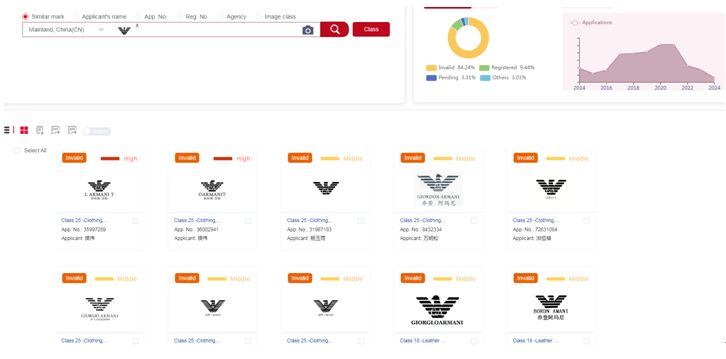- with Finance and Tax Executives
- with readers working within the Accounting & Consultancy industries
In the world of trademarks, graphic trademarks stand out as crucial elements of brand identity due to their unique visual appeal and rich cultural connotations. However, as market competition intensifies, determining the similarity of graphic trademarks has become a complex and nuanced challenge. This article explores common scenarios of graphic trademark similarity, discusses typical cases of infringement, and reveals the secrets of determining graphic trademark similarity with the help of the Kangxin IP Platform's trademark search function.
1. The Complexity of Graphic Trademark Similarity: Diversity and Intricacy
Graphic trademarks are vital components of brand identity, encompassing a wide range of forms such as geometric shapes, animals, cartoon characters, and natural elements. While these trademarks are distinctive in their creativity and design, certain similar elements can raise issues of similarity and potential confusion.
Geometric Graphic Trademarks:
Geometric graphic trademarks are composed of simple lines and
shapes, such as circles, triangles, and rectangles. These basic
geometric shapes are widely used in trademark design, making it
easier for similar trademarks to arise. For example, two trademarks
that both use a combination of circles and triangles may, despite
differences in details, create a similar overall visual effect that
could confuse consumers.The trademarks  filed by the same trademark squatter are
similar to the real owner's trademark, "
filed by the same trademark squatter are
similar to the real owner's trademark, " ".
".
It is worth noting that overly simple geometric shapes lack
distinctive features and thus cannot be registered as trademarks.
For example, a simple square like  , does not have the ability to distinguish the
source of the goods or services and thus cannot be registered as a
trademark.
, does not have the ability to distinguish the
source of the goods or services and thus cannot be registered as a
trademark.
Animal Graphic Trademarks:
Animals are common elements in trademark design, offering
vibrant imagery and rich symbolic meaning. However, when multiple
trademarks use similar animal images, issues of similarity may
emerge. For instance, two trademarks featuring rabbit images,  even if differing in posture and detail, may
still lead to consumer confusion due to their overall resemblance
and implied meaning, and thus are considered as similar marks.
even if differing in posture and detail, may
still lead to consumer confusion due to their overall resemblance
and implied meaning, and thus are considered as similar marks.
Cartoon Character Graphic Trademarks:
Cartoon character trademarks are popular for their unique shapes
and appealing imagery. However, determining similarity among such
trademarks can be more challenging. For example, two trademarks
featuring similar cartoon characters may, despite differences in
expression, clothing, or other details, still confuse consumers if
the overall appearance and style are similar.In a case of
opposition against the trademark "![]() ", both the CNIPA and the courts have
determined that this opposed trademark is similar to the cited
trademarks
", both the CNIPA and the courts have
determined that this opposed trademark is similar to the cited
trademarks  in terms of animal
ears, eyes, and facial features, even though there are differences
in the mouth and other parts. Consumers are likely to perceive them
as different states of the same cartoon character, and therefore
believe that the opposed trademark and the cited trademark are
related or part of a series. Therefore, the opposed trademark is
considered as a similar trademark to the cited trademarks.
in terms of animal
ears, eyes, and facial features, even though there are differences
in the mouth and other parts. Consumers are likely to perceive them
as different states of the same cartoon character, and therefore
believe that the opposed trademark and the cited trademark are
related or part of a series. Therefore, the opposed trademark is
considered as a similar trademark to the cited trademarks.
Natural Element Graphic Trademarks:
Natural elements like landscapes, flowers, and celestial bodies
are also common in trademark design. These elements are widely
recognized and carry significant cultural connotations, making it
easier for similar trademarks to occur. For example, trademarks,
 are considered as similar marks
because,despite differences in composition and details, they both
represent essentially the same thing, which could potentially
confuse the relevant public about the origin of the goods or
services.
are considered as similar marks
because,despite differences in composition and details, they both
represent essentially the same thing, which could potentially
confuse the relevant public about the origin of the goods or
services.
2. Truth about plagiarism: Overall Shape, Reversal, and Key Element Similarity
In the determination of graphic trademark similarity, scenarios of copying trademarks are not uncommon. These plagiarism behaviors may involve overall resemblance, flipping, significant portion similarity, and other situations.
Overall Shape Similarity:
Overall shape similarity is one of the most common forms of
graphic trademark infringement. Infringers may subtly modify the
lines, shapes, or colors of an original trademark to create a new
graphic trademark that appears novel but is highly similar to the
original. For example, the trademarks,  are confusingly similar as they have almost
identical mark composition and colors.
are confusingly similar as they have almost
identical mark composition and colors.
Plagiarism in reverse:
Plagiarism in reverse occurs when an infringer reverses or
mirrors the original trademark and uses it as their own graphic
trademark. Although this approach alters the direction of the
trademark, it retains the main features and visual effects of the
original. For example, the trademark,  could be considered as a plagiarism in
reverse of the true owner's mark,
could be considered as a plagiarism in
reverse of the true owner's mark, , and the trademark,
, and the trademark,  is a copy in reverse to
is a copy in reverse to  .
.
Key Element Similarity:
Key element similarity refers to cases where the infringer
copies only the distinctive parts or core elements of the original
trademark and uses them as the basis for designing a new graphic
trademark. This method of infringement is somewhat concealed, as
the infringer may partially modify or innovate upon the original
trademark. For example, in comparison with thetrademark  of the rightful owner, the disputed trademark
of the rightful owner, the disputed trademark
 has more elements in its design.
However, the central design of a red heart combined with the letter
A in the disputed trademark is identical to the earlier trademark
of the rightful owner. The trademarks are similar in composition,
making it easy for consumers to be confused and mistaken about the
origin of the goods.
has more elements in its design.
However, the central design of a red heart combined with the letter
A in the disputed trademark is identical to the earlier trademark
of the rightful owner. The trademarks are similar in composition,
making it easy for consumers to be confused and mistaken about the
origin of the goods.
3. Kangxin IP Platform: The Intelligent Engine for Trademark Searches
In the complex process of determining graphic trademark similarity, the Kangxin IP Platform offers a convenient and efficient solution with its powerful search and intelligent recognition capabilities. The platform supports rapid retrieval and intelligent comparison of graphic trademarks, enabling precise identification of overall shape similarities, reversals, key element similarities, and other infringement scenarios.
The Kangxin IP Platform's trademark search function offers the following advantages:
Rapid Retrieval: Users can quickly search for similar trademarks worldwide by simply uploading or entering the graphic trademark.
Intelligent Recognition: The platform employs advanced AI technology to intelligently recognize key features such as the overall shape and key elements of trademarks.
Accurate Comparison: The platform's algorithms perform precise comparisons of trademarks, providing similarity scores and detailed comparison reports.
Using the  trademark as an
example, the search results are precise and could be done fast.
trademark as an
example, the search results are precise and could be done fast.

Image source: Kangxin IP Platform
Comprehensive Coverage: The platform covers trademark databases from multiple countries and regions worldwide, ensuring the comprehensiveness and accuracy of search results.
With the trademark search function of the Kangxin IP Platform (eservice.kangxin.com), businesses can easily address the challenges of determining graphic trademark similarity. Whether monitoring market dynamics, protecting brand rights, or combating infringement, the platform provides robust support and assurance.
Conclusion: Safeguarding Creative Boundaries and Precisely Identifying Infringement
Determining the similarity of graphic trademarks is a challenging and opportunity-filled domain. By gaining a deep understanding of common graphic trademark similarities, uncovering infringement scenarios, and utilizing the Kangxin IP Platform's trademark search function, we can better safeguard the creative boundaries of brands, accurately identify and respond to infringement. As we move forward on the path of trademark protection, let us work together to create a fairer and more orderly market environment!
The content of this article is intended to provide a general guide to the subject matter. Specialist advice should be sought about your specific circumstances.


